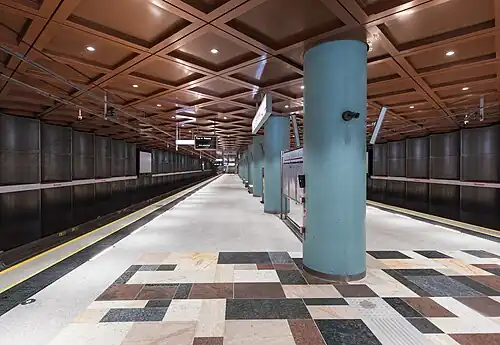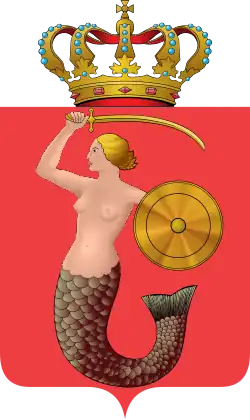Stare Górce
Stare Górce | |
|---|---|
 Appartment buildings around the Jeziorzec Pond in Górce, in 2015. | |
| Coordinates: 52°14′31″N 20°54′16″E / 52.241971°N 20.904435°E | |
| Country | |
| Voivodeship | Masovian |
| City and county | Warsaw |
| District | Bemowo |
| City Information System area | Górce |
| Incorporation into Warsaw | 14 May 1951 |
| Time zone | UTC+1 (CET) |
| • Summer (DST) | UTC+2 (CEST) |
| Area code | +48 22 |
Stare Górce (Old Górce) is a neighbourhood in the Bemowo district of Warsaw, Poland, in the western side of the City Information System area of Górce. It is a high-rise residential area dominated by apartment buildings. The neighbourhood features the Bemowo station of the M2 line of the Warsaw Metro rapid transit underground system.
In the 1940s, suburb neighbourhoods with single-family detached homes were built in the area, as the extension of the village of Górce. In the 1990s, the housing estates of apartment buildings began being developed in the area.
History
The area of the modern neighbourhood used to be farmlands owned by the village of Górce, which itself was founded before the 15th century.[1][2][3]
In the 19th century, several brickworks developed in the area, with the largest being Bogumił Schneider's factory in the nearby Jelonki.[4][5] They sourced clay locally, leaving behind pits, which over time flooded, forming numerous ponds. Most of them were filled in in the 1940s, during the development of new housing in the area, with two remaining to this day within Górce being Jeziorzec and Green Pond.[6][7]
In the 1920s, Górce became a suburb of Warsaw, with its lands being sold for the development of a low-rise neighbourhood with single-family detached homes.[3][6] It survived the Second World War without major damage.[1][3] During the conflict, and in its aftermath, the village rapidly developed with new housing, with people moving three after having their homes destroyed in Warsaw. Most of the new buildings were provisional structures built from wood or rubble recovered from destruction in the city.[3][6] In 1950, a tram line was opened, forming a connection between Boernerowo with Koło and Ulrychów, partially crossing the current boundaries of Górce, via Dywizjonu 303 Street.[8]
On 14 May 1951 the area was incorporated into the city of Warsaw, becoming part of the Wola district.[9][10] On 29 December 1989, following an administrative reform in the city, it became part of the municipality of Warsaw-Wola, and on 25 March 1994, of the municipality of Warsaw-Bemowo, which, on 27 October 2002, was restructured into the city district of Bemowo.[11]
In the 1980s, the area was cut vertically in the middle by Powstańców Śląskich Street, forming a boundary of two neighbourhoods, Stare Górce (Old Górce) to the west, and Nowe Górce (New Górce) to the east. In the 1990s, the western side begun to be developed with housing estates of high-rise apartment buildings, replacing old residential structures.[3][12] In the 1992, a tram line was built alongside Górczewska Streets. In 2015, it was expanded on Powstańców Śląskich Street.[13][14]
In the 1990s, the area began to be developed with housing estates of high-rise apartment buildings, replacing old residential structures. It was also cut vertically in the middle by Powstańców Śląskich Street, the area was cut vertically in the middle by Powstańców Śląskich Street, forming a boundary of two neighbourhoods, Stare Górce (Old Górce) to the west, and Nowe Górce (New Górce) to the east.[3][12] In the 1992, a tram line was built alongside Górczewska Streets. In 2015, it was expanded on Powstańców Śląskich Street.[13][14]
Between 2008 and 2011, a fragment of the Expressway S8, in form of Obrońców Grodna Avenue, was built crossing the neighbourhood.[15]
In 2022, the Bemowo station of the M2 line of the Warsaw Metro rapid transit underground system, was opened at the corner of Górczewska and Powstańców Śląskich Streets.[16]
Overview

Stare Górce is a residential neighbourhood dominated by high-rise apartment buildings.[3][12] It includes the Bemowo station of the M2 line of the Warsaw Metro rapid transit underground system, at the corner of Górczewska and Powstańców Śląskich Streets.[16] It also has three tram lines with tracks alongside Powstańców Śląskich Street, Górczewska Street, and Dywizjonu 303 Street.[8][13][14] Additionally, it includes two small ponds, Jeziorzec and Green Pond.[7] The neighbourhood is crossed by the Expressway S8, with section known as Obrońców Grodna Avenue.[15]
Boundaries
The neighbourhood boundaries are approximately determined by Dywizjonu 303 Street to the north, Powstańców Śląskich Street to the east, Górczewska Street to the south, and Lazurowa Street to the east.[3][12][17]
References
- ^ a b Encyklopedia Warszawy. Warsaw: Wydawnictwo Naukowe PWN, 1994. ISBN 83-01-08836-2. (in Polish)
- ^ Adam Wolff, Kazimierz Pacuski: Słownik historyczno-geograficzny ziemi warszawskiej w średniowieczu. Warsaw: Instytut Historii PAN, 2013. (in Polish)
- ^ a b c d e f g h Marek Wagner: Górce. Historia i pamiątki. Warsaw: INFORTeditions, 2020. ISBN 9788365982711. (in Polish)
- ^ "Warszawski park numer jeden? Nasze Moczydło". tustolica.pl (in Polish). 9 November 2017.
- ^ "Życie przed wielką płytą, czyli skąd się wzięły Jelonki". tustolica.pl (in Polish). 25 November 2016.
- ^ a b c "Górce: zagubiony zakątek Bemowa". tustolica.pl (in Polish). 23 February 2017.
- ^ a b Łukasz Szkudlarek: Analiza powierzchniowa zlewni. Charakterystyka i ocena funkcjonowania układu hydrograficznego, ze szczególnym uwzględnieniem systemów melioracyjnych na obszarze m.st. Warszawy wraz z zaleceniami do Studium uwarunkowań i kierunków zagospodarowania przestrzennego m.st. Warszawy i planów miejscowych. Warsaw: Warsaw, 2015, p. 14. (in Polish)
- ^ a b "Otwarcie było huczne. Tramwaj na Boernerowo ma już 90 lat". tvn24.pl (in Polish). 28 October 2023.
- ^ "Rozporządzenie Rady Ministrów z dnia 5 maja 1951 r. w sprawie zmiany granic miasta stołecznego Warszawy". isap.sejm.gov.pl (in Polish).
- ^ Andrzej Gawryszewski: Ludność Warszawy w XX wieku. Warsaw: Instytut Geografii i Przestrzennego Zagospodarowania PAN, 2009, p. 44. ISBN 978-83-61590-96-5. (in Polish)
- ^ Andrzej Gawryszewski: Ludność Warszaway w XX wieku. Warsaw: Polska Akademia Nauk, Instytut Grografi i Przestrzennego Zagospodarowania im. Stanisława Leszczyckiego, 2009, pp. 44–50. ISBN 978-83-61590-96-5. (in Polish)
- ^ a b c d Marcin Stępniak: Przekształcenia przestrzennego rozmieszczenia zasobów mieszkaniowych w Warszawie w latach 1945–2008. Warsaw: IGiPZ PAN, 2014, p. 65. ISBN 9788361590361. (in Polish)
- ^ a b c "Warszawa z nową trasą tramwajową na Powstańców Śląskich". transport-publiczny.pl (in Polish). 14 February 2015.
- ^ a b c Arkadiusz Kołoś: Rozwój przestrzenny a współczesne funkcjonowanie miejskiego transportu szynowego w Polsce. Kraków: Instytut Geografii i Gospodarki Przestrzennej Uniwersytetu Jagiellońskiego, p. 75. ISBN 9788388424212. (in Polish)
- ^ a b "S8 Konotopa – Powązkowska otwarta". archiwum.gddkia.gov.pl (in Polish). 24 January 2011.
- ^ a b "Metro jedzie na Bemowo. Dwie nowe stacje otwarte". transport-publiczny.pl (in Polish).
- ^ "Dzielnica Bemowo". zdm.waw.pl (in Polish).
